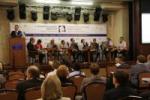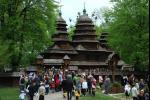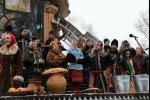The Ukrainian state during the late 17th century
The Hetman's State in Ukraine that Khmelnytskyi created had great potential for independence. However, these potentials were not realized for many reasons. It wasn't until the late 17th century that the domestic problems that tore Ukrainian society apart became more defined as a result of a policy of tsarism. The brutal struggle between some hetmans and claimants of the Hetmate broke out immediately after Khmelnytskyi's death. The country was drawn into the vortex of civil war, political crisis and economic displacement for many years.
The intricate socio-political situation required that existing problems be resolved quickly. Political mistakes and unweighted means in the social sphere made the available contradictions in the society too sharp. New Hetman I. Vyhoskyi (?-1664) pursued a course for the creation of an oligarchic republic and gradually lost the support of the greatest part of cossacks. Zaporizhia and a number of regiments in Left-Bank Ukraine who neglected the Hetman's aspirations proved to be in opposition to him. The Tsar's government, interested in weakening the Cossack State, also made its contribution to increasing civil disquiet. Governments of other neighboring states were also in a hurry to take advantage of this situation.
During the civil war, which began in Ukraine in the spring of 1658, its leader (first in the state's history) was the first to look for support from the foreign force (not to defend the state independence, but to fight with the domestic opposition and the rising people). He created the Tatar Horde in order to smash the rising regiment and the Cossacks headed by M. Pushkar and Y. Barabash decided to renew the union with Rich Pospolyta. The Hadiach agreement of September 16, 1658, provided for the return of Cossack Ukraine under the Polish crown as autonomous. The agreement's conditions changed the political system of the Hetman's power. In the socio-economic aspect of things, they renewed the pre-war forms of land ownership. Changes in the course of foreign policy as well as cruel measures of people in the Left Bank Ukraine area increased the discontent of Cossacks with I. Vyhovskyi reigning, and created a precedent of a split of the state. This created an elite group which was dangerous to the territorial unity of the state. A tendency of the Left Bank officers to be oriented with Moscow, and the Right Bank officers to be oriented with Warsaw was manifested and became more profound at this time.
Newly elected Hetman Yurii (about 1641-1685), a son of Bohdan Khmelnytskyi, could not prevent the increase of the troubling symptoms. The Chudnivsk agreement, which he made during the military campaign of 1660, practically recognized the validity of the Hadiach agreement. In 1663, deprived of real political support, Yurii Khmelnytskyi abdicated. The Hetman's mace in Left Bank Ukraine, owing to the support of the Tatars, came to the hands of General Secretary (Pysar) P. Teteria. Near the city of Nizhyn in 1663, the Chorna Rada, as it is called in Left Bank Ukraine, elected the Cossacks' chief, I. Briukhobetskyi (?-1668) to be Hetman. This was the division of Cossacks' Ukraine into two Hetmanates. The complete territory distribution of Ukraine between two states was confirmed by the Andrusiv truce of 1667 between the Moscow State and Rich Pospolyta. The Left Bank and Kyiv with surrounding territory stayed with Moscow the Right Bank remained under Poland and Zaporizhia was subject to both states. Some time later the territory dismemberment was confirmed by the clauses of the so called "Eternal" peace of 1686.
The signing of the Andrusiv agreement made the reunion of Ukrainian lands much more problematic. There was still deep socio-political contradictions between the state elite which were oriented to different foreign forces and continual interference of the latter to the domestic life of Ukraine, and both of its regions were bound into a single state organism by political and economic factors. The prospects of the territory consolidation of the Left and Right Banks became most visible in the period of the reign of P. Doroshenko (1627-1698), who was a colonel from Pryluky. Being one of Khmelnytskyi's fellow warriors, the Left Bank Hetman belonged to the convinced supporters of the existence of a single powerful Ukrainian state. In order to achieve this aim he began fighting with Poles, and made an agreement with the Tatars. He then negotiated with representatives of the Moscow Tsar and Left Bank Hetman I. Briukhovetskyi. He succeeded in uniting both of the territories under his mace for a short time. The interference of Russia and Rich Pospolyta which extended a campaign against the Hetman made this victory an unstable one. The Cossacks' Ukraine proved to be drawn into a new vortex of political struggle and internecine wars. At the beginning of July 1668, P. Doroshenko had to leave Left Bank Ukraine. Then in March of 1669 at the Cossacks' Council in Hlukhiv they elected a Chernihiv colonel who was supported by Moscow, D. Mnohohrishnyi (?-1696), to be Hetman of Left Bank Ukraine. The agreement he had with the Moscow government essentially limited the sovereignty of the Ukrainian state.
Under the new conditions, P. Doroshenko, supported by the Korsun Council in March 1669, became inclined to accept the Turkey protectorate. At the same time, he did not think it impossible to come to an understanding with Moscow or Rich Pospolyta, but on the condition that their governments would recognize the sovereignty rights of the single Cossacks' Ukraine. Doroshenko's political career ended in 1676.
At the General Council in Pereiaslav, General Judge I. Samoilovych was elected a Hetman of Cossacks' Ukraine "on both sides of the Dnipro". He succeeded in holding the Hetman's mace for fifteen years. He was an autocrat and loyal to his officers and to the Tsar. He was also oriented to the creation of the aristocratic state with the Hetman's power. He resisted the attempts of the Zaporizhia chiefs to affirm their political independence and often expressed his discontent with the Moscow government. They had renounced the right for Left Bank Ukraine in favor of Poland. He always tried to draw the attention of Moscow and Rich Pospolyta to the fact that the Right-Bank Ukraine and West Ukrainian Lands with the Left Bank Ukraine can be a single state body.
Late in the 17th century, one could observe considerable changes in the social sphere of life in Cossacks' Ukraine. The Hetmanate was a multi-class social organism. The population mainly consisted of peasants who had conquered their personal freedom with weapons, and for some period, they owned their own land. However, due to historical conditions, all the actions of the Hetman's administration (both economic and socio-political) were subject to interests of the Cossack upper layers. They were the privileged class in society at that time. They obtained the right to possess land, to occupy them in production activity, and to take part in the political life of the state.
Ukrainian membership in the Moscow state also influenced its economic development. In particular, certain changes took place in the Hetmanate foreign trade and economic relations. The country painfully lost its traditional western trade routes and sales markets. They were gradually reoriented to Moscow.
The institutions of the Ukrainian state system, formed in the years of the Liberation War, still functioned in the second half of the 17th century within the borders of the Hetmanate. However, the Russian government began the limitation and later liquidation of the traditional military-political system of Ukraine. The offensive of Moscow also touched the Ukrainian Orthodox Church, which from 1686 was subject to the Moscow patriarchy. The decades after 1654 gave the impetus to gradual but inflexible processes when the Ukrainian state lost its ethnic features and the whole socio-political institution was being liquidated.








